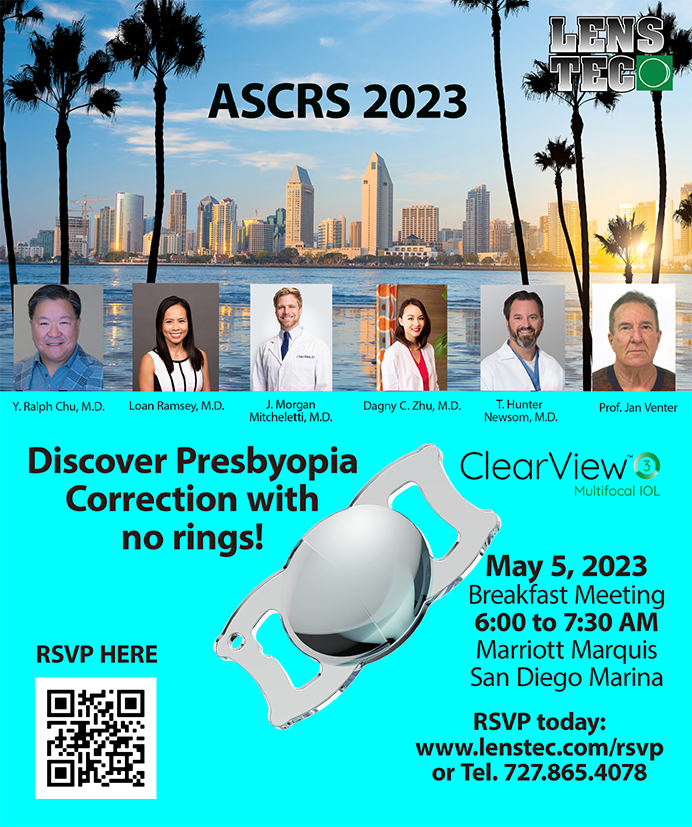Today's Practice | Aug 2005
Addressing the Weakest Link in Refractive Surgery
Measuring and assessing telephone skills.
Shareef Mahdavi
This is the first in a series of articles that highlights results from market studies on topics of interest to refractive surgeons. These studies comprise original research conducted by SM2 Consulting of Pleasanton, California.
Ten years after the first excimer laser was approved in the US, there is enough industry experience in marketing laser refractive procedures to identify the weak links in the process. Procedural advertising, although expensive and often subpar in quality, has created consumer awareness and can make the telephone ring with inquiries. Fast forward to the consultation: once inside the practice, the majority of qualified candidates move forward to undergo surgery. Between the ad and the consultation, however, is the patient's initial telephone call. My group's research hypothesis has long been that this second step in the process has proven the most difficult for providers. Virtually every surgeon with whom I speak has an inflated view of the actual skill of their phone answering team. In reality, most telephone counselors struggle with being able to effectively convert a caller's initial interest into a scheduled consultation. Any improvement in this area would directly benefit the refractive practice.
SM2 Consulting conducted a study funded by Carecredit (Costa Mesa, CA) to independently assess and measure the current abilities and skills of personnel in refractive practices when answering consumers' telephone inquiries. The data collected in the study may be used in two ways: (1) as objective feedback that practices may use to improve their service and (2) as a survey tool and industry benchmark of phone skills across a large sample of practices from around the country.
METHODOLOGY
Our firm developed a survey tool that covers 13 aspects of a phone call between a potential refractive patient and a refractive counselor (Figure 1). The topics cover everything from the counselor's initial greeting when he or she first answers the phone to the skill with which he or she closes the call. This survey tool was reviewed by an independent group of ophthalmic administrators and validated in a pilot study of six centers from around the country.
Seventy-seven practices nationwide volunteered to participate in the study. They were spread evenly across the country and represented modest-, moderate-, and high-volume LASIK practices. All of them signed an informed consent authorizing the placing and recording of phone calls.
We used a “mystery shopper” technique in which each phone call was made by a person posing as a consumer interested in LASIK. Employees of Opticall (Sarasota, FL), a professional call center that provides call coverage for refractive practices, made the calls. Opticall's employees are professionally trained and skilled in handling incoming calls from interested patients and are thus well suited to playing the role of a mystery shopper.
The callers graded the phone counselors on each of the 13 topics on a scale of 1 (poor) to 5 (excellent). They used specific criteria to define a score of 1, 3, or 5. Figure 2 provides an example of these criteria. The caller would give a score of 2 or 4 when he or she believed that the counselor's effort fell in between the defined criteria.
The callers attempted five separate phone calls for each practice participating in the study. They made the calls at different times of the day and week to eliminate possible bias. On the data collection form, we recorded the length of the call and any comments from the mystery shopper.
SM2 Consulting collected and independently analyzed the data from 304 completed calls made to the 77 participating practices. We excluded calls that were sent to voicemail or placed on hold for longer than 3 minutes from the data analysis. Finally, we gave each practice a detailed report with the scores for each phone call and their comparison with the average across all participating practices, as well as an audio CD with recordings of each call made to their practice.
DATA ANALYSIS AND RESULTS
We calculated average scores for each topic, each call, and each practice. We determined a score of 3 to be good, its being midway between poor and excellent using the five-point scale. In addition to the raw scores, we created an indexed total call score of 100 possible points that gave more weight to certain topics that we deemed more advanced (eg, the ability to differentiate the practice's offering) than basic ones (eg, the amount of time it took to reach a counselor). We also analyzed the data for any differences between high- and low-volume practices.
Figure 3 shows the average raw scores by topic for all phone calls to all practices. An average score of 3 or higher was achieved in only three of the 13 areas measured on the phone call: the warmth of the greeting when the phone was answered (mean score = 3.6), the time it took to reach a LASIK counselor (mean score = 4.2), and the ability of the counselor to control the flow of the conversation (mean score = 3.1). The ability to qualify the needs and interests of the caller was the topic on which counselors scored the lowest, with a mean score of 1.8. We rated fully 60% of the phone calls as poor in this area.
Two other very important elements of the phone call also scored below expectations. More than half of the calls (57%) were rated poor on the counselor's ability to differentiate the practice's offering from those of other providers (mean score = 2.1). Similarly, 46% of calls were rated poor in the attempted call to action, a measure of the counselor's effectiveness in moving the caller to the next step in the process (eg, signing up for a consultation, attending a seminar, or viewing a surgery).
In only one of every three calls did the counselor ask the caller how he or she had heard about the practice (Figure 4). Similarly, counselors offered callers additional resources to learn about the LASIK procedure only approximately half of the time.
Consequently, the low raw scores, when translated into total scores, yielded an average call score of 49 (out of 100 possible points). The benchmark for a good total call score was 57 points, which the counselor would achieve by receiving a score of 3 for each of the topics measured. Only 19 of the 77 practices achieved an average call score that met or exceeded this benchmark for a good average score of their phone calls.
ADDITIONAL ANALYSES
Length of Call
Practices with an average call length that was longer than 5 minutes had average call scores that were significantly higher than those of practices with calls shorter than 5 minutes. Based on the data, the optimal length of a phone inquiry appears to be between 5 and 8 minutes. Conversely, practices with an average call length of under 1 minute (presumably due to a desire to schedule a consultation with the caller and withhold all information until that event) scored significantly lower.
Incomplete Calls
Twenty-six percent of all attempted calls were put into voicemail, and 2% of them were placed on hold for longer than 3 minutes.
DISCUSSION
This study is the largest assessment to date of counselors' telephone skills across a wide range of providers of refractive surgery in the US. For many refractive surgeons, this has not been an area of great attention or focus. Most of those with whom I speak assume that phone calls in their practices are handled adequately and are shocked when they hear (via recorded calls) what is actually happening.
The low scores confirm our hypothesis that the telephone is an area of weakness on the business side of refractive practices and that it is in need of great improvement. The most distressing findings were counselors' inability to differentiate their practices and the lack of information they collected to determine the source of callers' awareness of the practice. Differentiation is the key to giving prospective patients a reason to select a particular practice. Without it, all providers look the same, and refractive surgery risks becoming viewed as a commodity. “How did you hear about us?” is one of the most basic pieces of data required to help any small business decide how best to invest precious marketing dollars. It was simply astounding that this question was asked in only one-third of all completed calls.
Additionally, an analysis of the average call length revealed that certain practices strive to keep the phone calls as short as possible. Listening to those calls makes it clear that their sole objective is to get the patient to schedule a consultation in as brief a conversation as possible, presumably to leave all the “heavy lifting” until the prospective patient has come into the office. In an emotionally laden decision-making process, that simply is not an optimal means of building rapport and trust with potential customers.
The encouraging news is that each one of the participating practices now has objective data that it may use to better educate and train those staff members responsible for providing the first impression of callers into the practice. The recordings have become an invaluable teaching tool, allowing all personnel to hear exactly how questions are being answered during inquiries.
As an industry, we now have a way to measure counselors' phone skills and monitor their improvement over time. The incentive for providers and manufacturers to utilize such assessments is strong: better phone skills will translate into a higher percentage of callers scheduling consultations. Even if conversion rates from consultation to surgery stay the same, more refractive surgery will be performed.
Shareef Mahdavi draws on 20 years of medical device marketing experience to help companies and providers become more effective and creative in their marketing and sales efforts. Mr. Mahdavi welcomes comments at (925) 425-9963 or shareef@sm2consulting.com. Archives of his monthly column may be found at www.crstoday.com.
Practices interested in having their counselors' phone skills assessed may contact Kim Gibson at Carecredit at (800) 300-3046, ext. 4133; kgibson@carecredit.com.




